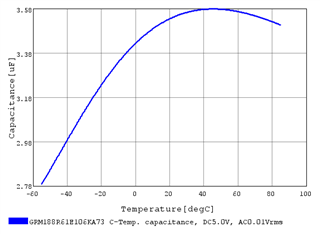Tool/software:
Hi Team,
Please review the attached schematics for Vin = 5V, Vout = 0.75V. Also attached is the component calculator sheet.
/cfs-file/__key/communityserver-discussions-components-files/196/TPSM8287A15BAHRDWR_5F00_0V75.pdf
Thanks
This thread has been locked.
If you have a related question, please click the "Ask a related question" button in the top right corner. The newly created question will be automatically linked to this question.
Tool/software:
Hi Team,
Please review the attached schematics for Vin = 5V, Vout = 0.75V. Also attached is the component calculator sheet.
/cfs-file/__key/communityserver-discussions-components-files/196/TPSM8287A15BAHRDWR_5F00_0V75.pdf
Thanks
Hi,
Thanks for using the calculator!
Your chosen Rcomp1 value is much larger than the calculator suggests. Also, the output capacitance entered is the nominal value, not the effective value. Why is that?
Can you send the part numbers for the 10uF Cin and the 100uF Cout?
Also, the EN pin needs at least a 15k resistor in series with it.
Thanks,
Chris
Hi Chris,
1. For cross-verification, I calculated the Rcomp1 and output capacitance value using the formula in datasheet and used it in design.
2. According to calculator Rcomp1 calculated is 8.21K, will it be good if I use 8.2K? .
3. As for output capacitance for 8.2K Rcomp1, i will use 8x 100uF, 1x 47uF for a total of 847uF capacitance, will that be good?
4. Based on 8.2K Rcomp1 and 847uF output capacitance, will 430pF Ccomp1 be good?
5. 10uF - GRM188R61E106KA73D, 100uF - GRM21BR60J107ME15L, 47uF - C3216X5R1E476M160AC
6. Is it fine to leave SCL, SDA and SYNC_OUT pins floating?
7. Is it necessary to provide pull-up for PG pin or can I leave it floating?
Thanks
Hi,
Thank you for explaining.
Those input caps do not provide the required 5uF effective Cin, under DC and AC bias voltage. Can you use this cap instead? GRM188C81A226ME01D

Depending on your temperature range, those 100uF Couts have between 58 and 70 uF of effective Cout. This is the value that you need to use in the spreadsheet, as it is how much capacitance is actually present in the circuit.

From your spreadsheet, I picked a 3.74k Rcomp1 resistor. Then, the 8x 100uF caps give sufficient capacitance. Ccomp1 is then about 1000pF.
Yes, you can leave PG and SYNC_OUT floating. You should connect SDA and SCL to GND, if not using them.
Chris
Hi Chris,
1. According to calculator Rcomp1 calculated is 8.21K, will it be good if I use 8.2K?
2. As for output capacitance for 8.2K Rcomp1, i will use 8x 100uF, 1x 47uF for a total of 847uF capacitance, will that be good?
3. Based on 8.2K Rcomp1 and 847uF output capacitance, will 430pF Ccomp1 be good?
4. 100uF - GRM21BR60J107ME15L, 47uF - C3216X5R1E476M160AC
5. Instead of using 2x 10uF, will using 2x 22uF (GRM188C81A226ME01D) suffice for Cin?
Also find the component calculator attached.
Thanks
Hi,
1.This is a very large Rcomp value. Are you sure that you have an 8A load step and require 1% deviation to that step? This is making Rcomp and Cout very large.
2. I don't think this is enough capacitance, since the effective capacitance will be less than the nominal value. You need to enter the effective capacitance in cell C26.
3. No, I think this is too high. You need to enter the actual, effective capacitance first.
4. Ok.
5. Yes, those give enough effective capacitance for Cin.
Chris
Hi Chris,
1. I have an 8A step load in my application, so is the selected value fine?
2. I will increase the number of 100uF capacitors to 12 and 47uF to 2 for Cout, is that sufficient?
3. Considering the above points is Ccomp1 good?
Thanks
Thank you for confirming.
1. Yes, if you have an 8A step, that is the right value to enter. You also should enter the correct slew rate of that load change in cell C8. And is the allowed voltage deviation just +/-1% (cell C6)? That is quite small.
2. Depending on your temperature range, that still may not be enough capacitance based on the curves I shared earlier.
3. Yes, 430pF is in the right ballpark. Depending on how much effective Cout you use, 390pF may be a better value.
Chris